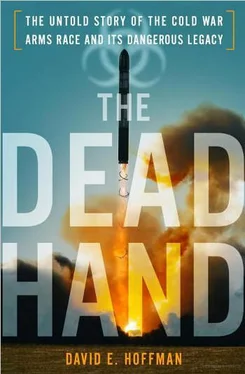At Koltsovo, scientists like Popov broke through barriers of knowledge, but building actual weapons was the job of the military, which maintained its own separate laboratories. Vector was a research facility. The “customer” was the 15th Main Directorate of the Ministry of Defense. Periodically, the customer came to visit Vector, to check on progress. And there was finally something to tell them.
Secluded in the forests outside of Moscow, another scientist was fighting his own battle. While Vector sought to alter viruses, Igor Domaradsky attempted to reengineer the genetic makeup of bacteria into an unstoppable warrior. Domaradsky walked with a slight limp; he had suffered polio as a child, and tuberculosis and malaria as an adult. He had a reputation for being irritable, hard to contain, and he later called himself a troublemaker, an inconvenient man. He was always restless. He yearned for the rewards of scientific discovery but worked in service of weapons of death. 8
In 1984, he was fifty-nine years old. During the week, he lived alone in Protvino, a small town one hundred miles south of Moscow. He drove through the mixed forests of birch and bogs each day to start work at a secret laboratory. The location was called Obolensk, after ancient princes who once ruled the forests. He was fond of the drive, and often, in winter, came face-to-face with roaming elk. He remembered when Obolensk was carved out of the woods. At first, there were temporary “huts,” long, crude one-story barracks for researchers. By the early 1980s, the modern Korpus No. 1 rose out of the forest. Outwardly, it appeared to be another eight-story, boxy Soviet office building. But inside it was 400,417 square feet dedicated to the study and manipulation of dangerous pathogens. The third floor was devoted to especially hazardous materials. Massive airlocks and seals guarded against leaks. 9Obolensk itself was dark and marshy, and Domaradsky considered it a privilege to have his apartment ten miles to the south in Protvino, in the fresh air near the banks of the Oka River.
The laboratory at Obolensk was known as Post Office Box V-8724, one of dozens of closed Soviet cities and laboratories devoted to Cold War military work. 10Domaradsky worked in the laboratory during the week, living in his Protvino apartment, and drove two hours back to Moscow to see his family on weekends, sometimes lingering in the city on Monday. His wife, Svetlana Skvortsova, was a talented actress and teacher who thrived in Moscow’s rich cultural life. Domaradsky worked in lonesome isolation.
The enforced solitude caused him to ponder all that he had done. In the apartment, he began collecting papers and hiding notes of his life’s work, making illicit photocopies so the evidence of his achievements would not be destroyed by the secret services that watched over him.
On weekday mornings, Domaradsky switched on the radio in his apartment to listen to Radio Free Europe, the BBC and Deutsche Welle, the German broadcaster, which were easier to receive in the countryside than in the big cities. “Nobody bothered me, and I luxuriated in my freedom to listen to foreign radio, learning a great deal of news about the USSR and the world that was not available in Moscow.” He would then put on a record of his favorite music. Sometimes he went skiing, in the mornings or evenings after work, through a park and forest. Food shortages were common, but Domaradsky was permitted to shop at the small elite “Ryabinka” grocery store for directors of a nearby physics institute. While Soviet citizens were in lines for the basics, the store carried such rare commodities as instant coffee and caviar, delivering them to his door and taking his order for the next delivery. He felt well off, but his science was difficult, and its goals, he knew, were dreadful.
Tularemia, commonly known as “rabbit fever,” is caused by a bacterium that is highly infectious. It is formally known as Francisella tularensis and is found in animals, especially rodents, rabbits and hares. In the early 1980s, the microbe became the object of Domaradsky’s research. He yearned to work on several other pathogens at the same time, but the Soviet bosses wanted results from tularemia. He was searching for a way to make tularemia into an agent that would infect people while resisting both antibiotics and vaccines. He was searching for an unstoppable supergerm.
In general, the Soviet military preferred to use contagious pathogens like the smallpox virus and plague because they could cause epidemics. The military would simply light the spark, and the disease would spread like wildfire on its own. Tularemia is not contagious, and thus cannot be passed from human to human. Yet the military retained interest in tularemia because it required as few as ten microorganisms inhaled or ingested to infect someone. 11Tularemia is also stable and easy to aerosolize; the microorganism can survive for weeks at low temperatures.
Unlike viruses, which are nothing more than a few genes and protein, with perhaps a membrane, bacteria live inside rigid outer walls. The wall is critical to the cell’s survival, giving it structure and support. Without it, the cell dies. In the 1930s and 1940s, antibiotics were developed that could attack bacteria; the first was penicillin. These drugs could slow or even kill the bacteria in several ways: weaken the cell wall, inhibit its growth or stop its replication. Antibiotics helped defeat infections that have threatened man through the centuries. Diseases such as rheumatic fever, syphilis and bacterial pneumonia became easily treatable. These miracle medicines held promise that some diseases could be wiped out. By the 1940s, there were dozens of antibiotics, but then came another twist: bacteria acquired resistance to them. Within a few years, many of the powerful wonder drugs were losing their efficacy. The remaining bacteria were no longer vulnerable to antibiotics, as a result of natural selection—those which were genetically able to resist the drugs had survived. Over time only the resistant bacteria remained, and the drugs lost their effectiveness. 12
The goal of Domaradsky’s research was to build a new microbe that would be resistant to many antibiotics. As an instrument of war, it would slice through helpless populations or armies like a scythe. According to Ken Alibek, who rose to become deputy director of the Soviet bioweapons program in the late 1980s, Domaradsky had once proposed to develop a strain of tularemia that would stand up against a whole spectrum of antibiotics, overcome vaccines and at the same time not lose its virulence. “The Soviet army wasn’t satisfied with weapons resistant to one type of antibiotic,” Alibek said. “The only worthwhile genetically altered weapon, for military strategists, was one that could resist all possible treatments.” 13The generals wanted a strain that could resist up to ten different antibiotics at once, Alibek recalled. The proposal was audacious, complex and difficult to fulfill.
Domaradsky had little to work with. Knowledge in the Soviet Union about the tularemia microbe was scant. “We had no data on its biochemistry or its genetics,” he said. Domaradsky persuaded the Moscow authorities to let him recruit the best researchers in the country for his project.
By his own account, Domaradsky’s long struggle was complicated by constant pressure from the Soviet leadership, which wanted results delivered on a rigid schedule of five-year plans. The biological weapons program was under the purview of a powerful agency, the Military Industrial Commission, which set down deadlines that Domaradsky found infuriating. By 1984, he had been working on the tularemia idea for nearly eight years. Every month, the bosses arrived from Moscow in official cars, driving up to Obolensk with sirens wailing and lights flashing. The visitors, impatient, wanted to know how the project was going, and turned to Domaradsky. His research was slow and painstaking. “That microbe does not recognize genetic information, nor does it possess the right genes for antibiotic resistance on its own,” he said of tularemia. While Domaradsky reported making progress toward conquering resistance to antibiotics, he said, “we were nowhere near” the second goal of creating a germ that could also overcome vaccines.
Читать дальше












